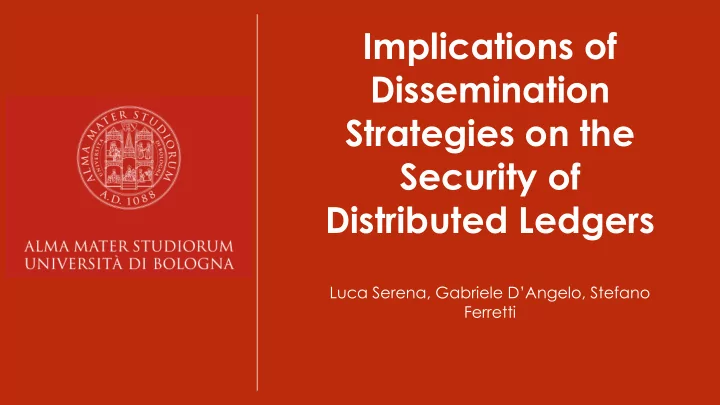

Implications of Dissemination Strategies on the Security of Distributed Ledgers Luca Serena, Gabriele D’Angelo, Stefano Ferretti
Dissemination Protocols Dissemination protocols = Algorithms to spread the information within a peer to peer system There are several strategies that can be applied, depending on the features required. The features that one can be interested to optimize are: Coverage , that is the percentage of the nodes that receive the ● message. Efficiency , it is often desirable to minimize the network traffic ● Anonymity , in certain systems it is desirable to hide the real identity of ● the sender of a transaction
Gossip Protocols Fixed Probability ● Probabilistic Broadcast ● Dandelion ● Dandelion ++ ●
Dandelion Dandelion consists of two phases: Stem phase = the message is sent to just one neighbor that is selected at random Fluff phase = the message is broadcasted, all the neighbors receive it
Dandelion ++ Based on Dandelion but with some improvements: Greater guarantees against deanonymization attacks ● A fail-safe mechanism improves the security against Denial of Service ● attacks Dandelion ++ is currently used by Zcoin and Monero
LUNES-blockchain Lunes-blockchain is a discrete events simulator that is able to reproduce the behaviour of a Bitcoin-based blockchain and to simulate certain attacks on the system. It consists of three phases that are executed separately: Network Creation ● Simulation Execution ● Attacks Evaluation ●
Sybil Attack The Sybil Attack is a type of Denial of Service attack where an attacker creates a large number of pseudonymous identities and uses them to gain a disproportionately large influence. In our case the attacker will not relay the transactions of a certain node.
Setup and Methodology In order to evaluate the influence of the attack, the execution is repeated 99 times, each time with an increasing percentage of malicious nodes. The malicious nodes are chosen at random among all the nodes and the results of each run are an average of some hundred executions, in which the identity of the victim is always changed. The graphs are populated by 10000 nodes, the coverage is given by the percentage of honest nodes who received the message by the victim.
Tests on Probabilistic Broadcast
Tests on Fixed Probability
Tests on Dandelion
Tests on Small World topology The previous tests were made on random graphs. The tests were then repeated on a small world graph, to check if the topology of the network could influence the results, but it turned out that no significant change could be noticed.
Conclusions The average degree of the nodes plays an important role for resisting ● to Sybil attacks Dandelion is easily vulnerable to Sybil attacks, but Dandelion++ gives ● the same level of resilience as pure broadcast In all the tested network configurations, with Probabilistic Broadcast ● and Fixed Probability having 40% or lower of malicious nodes does not compromise the system
Recommend
More recommend